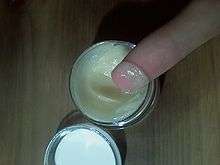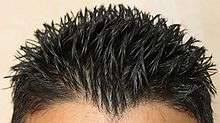Hairstyling product
Hairstyling products are used to change the texture or shape of hair or to hold a certain hairstyle in place. If applied properly, most styling products will not damage the hair apart from drying it out, since most styling products contain ingredients that can dissolve natural oils. Many hair products also contain ingredients which can cause build-up, resulting in dull hair. This may result in several problems such as dry hair, hair breakage, eczema, thinning of hair, etc.
History
Hairstyling products have had a significant impact on the creation of certain hair styles/trends throughout history. In 1948, Chase Products became the first company to package hair spray. Hair spray became very popular in the 1950's due to its ability to keep hair in place and prevent hair styles from falling out.[1] For the ancient Egyptians, physical appearance was very important to the embalming process used in the creation of mummies. Hair was often styled to maintain the individuality of the deceased. A fatty substance, modernly known as hair gel, was used to style hair and keep it in place.[2]
Types of hairstyling products
Hair wax

Hair wax is a thick hair styling product containing wax, which helps in holding the hair. It does not harden as some products would, such as hair gel but it leaves hair pliable. Hair wax has been used for many years. In fact, a waxy soap-like substance was invented by the ancient Gauls as a hair styling agent and was not used as a cleaning agent until many years later.[3] According to Elle, the world's best-selling fashion magazine, hair wax is one of the most popular beauty products. Many manufacturers are creating new technologies in hair removal and releasing different versions of hair wax, such as pomade, putty, glue, glypto, whip, and styling paste.[4]
Hair mousse
Hair mousse is a toiletry added to hair for extra volume and shine. It often comes in either spray or cream form. It adds volume without any clumps or buildup.
Apply to hair when hair is wet or damp, not dry. Apply all around and comb hair afterwards to make sure that the mousse is evenly spread.
Hair mousse is purple inside the can, but when released the isobutylene[5] makes it an off-shade white.
Pomade
Pomade (also called pomatum) is a greasy or waxy substance that is used to style hair. Pomade makes hair look slick and shiny. Unlike hair spray and hair gel, pomade does not dry and often takes several washes to remove - a special shampoo, though, may be used. Other products which make hair less greasy include olive oil, dishwashing liquid, and lemon juice. Most pomades contain petroleum jelly (and in fact petroleum jelly can be used alone as a pomade) and mineral oil, and many also contain some sort of wax. They may also contain perfume and colouring agents. A plethora of pomades are still in production today and vary in factors such as weight, shine, and scent. The stiffest will have a higher proportion of beeswax[6] while the lightest may have a higher proportion of oils.
Hair gel

Hair gel is a hairstyling product that is used to stiffen hair into a particular hairstyle. The result that it produces are usually similar to, but stronger than, those of hair spray and hair wax, and weaker than those of hair glue.
Hair spray
Hair spray (also known as spritz, or sticky water) is a common household aqueous solution which is used to keep hair stiff into a certain style. Weaker than hair gel, hair wax, or hair glue, it is sprayed to hold styles for a long period. Using a pump or aerosol spray nozzle, it sprays evenly over the hair. The product may leave hair feeling "crunchy" unless brushed out. Hair spray was first developed and manufactured in 1948 by Chase Products Company, based in Broadview, Illinois.[7]
Its active ingredient is the chemical elastesse. Elastesse is a form of liquid elastic that keeps the hair stiff and firm without snapping.
The solvent used was once a compound of carbon, fluorine, and chlorine (a chlorofluorocarbon, or CFC). CFCs are nontoxic, nonflammable, and make almost ideal aerosol propellants. However, when it was learned that they cause destruction of stratospheric ozone, they were replaced with other solvents, like alcohols and hydrocarbons.[8]
One of the polymers used is polyvinylpyrrolidine. A non-water-soluble polymer called polydimethylsiloxane is added to make the hold last a bit longer (the polyvinylpyrrolidine is water-soluble). Pytocalcious chemicals are another family of ingredients in hair spray, which increase the amount of minerals in the hair's root causing the hair to become stiff.
Other polymers used in plastic-based hairsprays are copolymers with vinyl acetate and copolymers with maleic anhydride.
Some hair sprays use natural polymers and solvents like vegetable gums dissolved in alcohol. One popular ingredient is gum arabic, which is made from the sap of certain species of the acacia tree. Gum tragacanth is another herbal gum that is used to stiffen calico and crepe, as well as hair.
Hair Volumizer
Hair volumizers are used to temporarily add volume, body, and shine to thin or flat hair. Hair volumizers are also used by balding men to make their hair mass look dense. They come in many forms like shampoos, conditioners, sprays, pomades and lotions.
Hair volumizers contains humectants, which work by attracting moisture from the surrounding areas to the hair strand, thereby swelling the hair and making it look thicker. Various polymers present in the volumizer coat the hair strand, making it look thicker and shiny.
Shampoo and conditioner forms of the volumizers are used just like ordinary shampoo or conditioners. The spray and lotion form of volumizers are used on damp hair, near the roots of the hair. In use, the person flips their head downward and gradually blow dries the hair, with the air being blown along the shaft of the hair until the hair is dry.
Misc
Other types of products include serums, leave-in conditioner, clays, hair tonic, hair dry powder shampoo, and heat protection spray.
See also
References
- ↑ "Hair Spray facts, information, pictures | Encyclopedia.com articles about Hair Spray". www.encyclopedia.com. Retrieved 2016-10-26.
- ↑ McCreesh, N. C.; Gize, A. P.; David, A. R. (2011-12-01). "Ancient Egyptian hair gel: new insight into ancient Egyptian mummification procedures through chemical analysis". Journal of Archaeological Science. 38 (12): 3432–3434. doi:10.1016/j.jas.2011.08.004.
- ↑ "All about hair wax". monplatin-news.com. 2013-04-15. Retrieved 2016-10-28.
- ↑ "History of Hair Removal". ELLE. 2013-03-28. Retrieved 2016-10-26.
- ↑ "Isobutene C4H8 - PubChem". pubchem.ncbi.nlm.nih.gov. Retrieved 18 November 2016.
- ↑ "BEESWAX: Uses, Side Effects, Interactions and Warnings - WebMD". www.webmd.com. Retrieved 18 November 2016.
- ↑ "Chase Products Co. - History". www.chaseproducts.com. Retrieved 2016-10-26.
- ↑ "The Montreal Protocol". www.unep.org. Retrieved 2016-11-03.